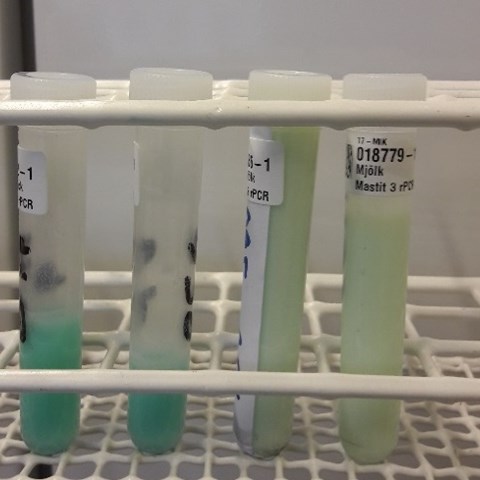Contact
Ulf Emanuelson, Researcher
Department of Clinical Sciences, SLU
ulf.emanuelson@slu.se, +46(0)18-67 18 26

Real-time PCR analysis of milk samples is a fast method to identify intramammary infections (IMI) in dairy cows, and has the potential to be used for routine analysis of test milking composite milk samples. However, the results of the PCR analysis can be difficult to interpret.
The objective of this study was to compare the sensitivity (Se) and specificity (Sp) of PCR analysis of composite milk samples, and conventional bacteriological culturing (BC) of quarter milk samples, when used to identify cows with IMI. The comparisons were performed for IMI with four common udder pathogens; Staphylococcus aureus (S aureus), Streptococcus dysgalactiae (Str dysgalactiae), Str uberis and coagulase negative staphylococci (CoNS). The Se and Sp of real-time PCR (SePCR; SpPCR) and BC (SeBC; SpBC) was simultaneously estimated using latent class analysis (LCA), studying one pathogen at the time. Milk samples from 970 dairy cows from 25 herds were included. Aseptically collected quarter milk samples taken at the day before test milking (TM), at the day of TM, and at the day after TM, were analyzed using BC. Non-aseptically collected composite milk samples taken at the day of TM were analyzed using PCR. Moreover, the composite milk somatic cell count (SCC) was recorded and summarized by diagnostic test and bacterial finding. LCA was first performed using only test results from samples taken at the day of TM, but in a second analysis BC results from the three consecutive samplings, interpreted in parallel, were included. The SePCR was significantly higher than the SeBC for S aureus, Str dysgalactiae and CoNS in the first analysis, but only for CoNS in the second analysis. The SpPCR was significantly lower than the SpBC for Str dysgalactiae and CoNS.
In conclusion, using PCR analysis of composite milk samples, as a diagnostic tool for identifying cows with IMI increased the Se for all the pathogens investigated (although not always significantly), while Sp in general remained on a similar level, compared to BC of quarter milk samples. The use of repeated quarter milk sampling improved the SeBC, making the results of PCR analysis and BC more similar. However, the SCC of cows with IMI according to BC was higher than for cows with IMI according to PCR, suggesting that some of the cows with IMI according to PCR did not have an active inflammation. Hence, extra caution is needed when decisions about treatment of IMI are based on PCR.
http://www.sciencedirect.com/science/article/pii/S0167587716305578
http://dx.doi.org/10.1016/j.prevetmed.2016.11.009
Nyman, A.-K., Persson Waller, K., Emanuelson, U., and J. Frössling. 2017. Sensitivity and specificity of PCR analysis and bacteriological culture of milk samples for identification of intramammary infections in dairy cows using latent class analysis.
Ulf Emanuelson, Researcher
Department of Clinical Sciences, SLU
ulf.emanuelson@slu.se, +46(0)18-67 18 26